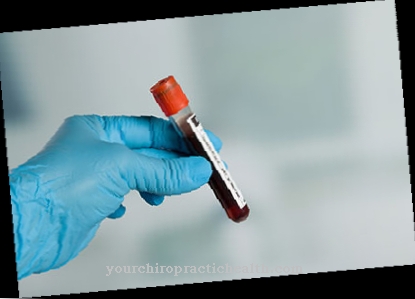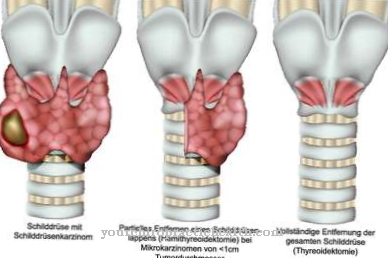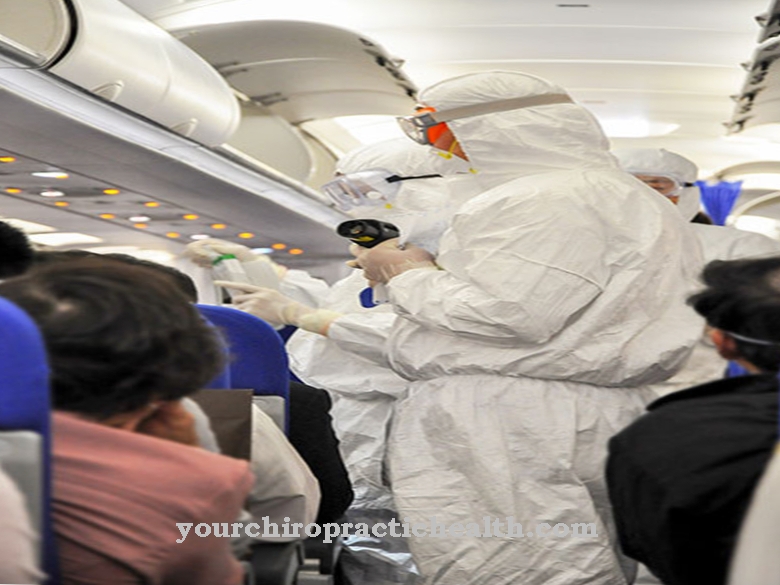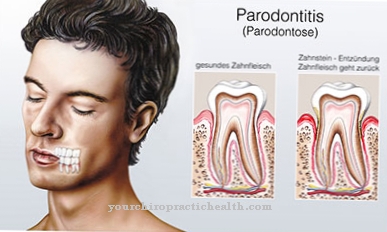Under one Ophthalmia neonatorum is understood to be conjunctivitis of the eye in babies. She is also called Neonatal conjunctivitis known.
What is ophthalmia neonatorum?

© kaloriya - stock.adobe.com
At a Ophthalmia neonatorum Conjunctivitis (conjunctivitis) of the eye occurs in the first few weeks of life of a newborn child. In most cases, both eyes are affected. Conjunctivitis can be caused by a variety of pathogens, most of which are bacteria. The incubation period for Ophthalmia neonatorum is between two days and two weeks. Complaints and course of Neonatal conjunctivitis depend on who caused them.
causes
Ophthalmia neonatorum shows up in the first 28 days of the baby's life. Gonococci such as Neisseria gonorrhoeae are considered the classic cause of conjunctivitis. However, there has been a significant reduction in gonococcal infections in the last few decades, so that today other germs are responsible for newborn conjunctivitis. These are mainly chlamydia.
These gram-negative bacteria are the cause of around 73 percent of all conjunctivitis in babies. Other possible causes are staphylococci, streptococci, pseudomonads or viruses such as herpes viruses. However, different environmental influences can also cause conjunctivitis in babies.
Medicine basically differentiates between infectious and non-infectious neonatal conjunctivitis. While the infectious ophthalmia neonatorum is triggered by bacteria and viruses, the non-infectious form arises from reactions to pollen, house dust, cosmetic products or hay fever. Other possible causes of the eye disease are chemicals, foreign bodies and excessive exposure to sunlight.
The contagious form, in turn, can be associated with a cold. It is not uncommon for the germs to be transmitted during the birth process by pressing themselves into the eyelids. A smear infection after the birth from one baby to another is also conceivable. Another circumstance that can lead to the development of neonatal conjunctivitis is that the tear ducts are not yet fully functional. This leads to a build-up of excess tear fluid, which cannot drain off properly.
Symptoms, ailments & signs
The symptoms of ophthalmia neonatorum can take a different course depending on the pathogen. Doctors refer to gonococcal infection as gonoblennorrhea. It is characterized by a large amount of pus. Also, the baby's eyelids swell, causing pus to protrude when the eyes are opened.
Because gonoblennorrhea causes ulcers on the cornea, it is considered a particularly dangerous form of ophthalmia neonatorum. This is how holes appear. In the worst case, there is even a risk of blindness. In the case of chlamydial blennorrhea, the baby's eyes swell and slimy pus develops.
Characteristic so-called inclusion bodies can be seen in the conjunctival cells. In medicine, the form of the disease is therefore also known as inclusion body conjunctivitis. If herpes viruses trigger the ophthalmia neonatorum, this is noticeable in the form of a swollen and reddened conjunctiva. In addition, vesicles filled with fluid form on the eyelid. Conjunctivitis caused by viruses is considered particularly contagious.
Diagnosis & course of disease
If conjunctivitis is suspected in a baby, a doctor should be consulted. For his examination, the doctor uses a special slit lamp, with the help of which he can examine the different eye structures enlarged. To examine the inner eyelids, they are folded down.
In order to be able to determine the pathogen, a smear is usually taken. The inclusion bodies in the scraped-off cells of the conjunctiva are an indication of a chlamydial infection. If an allergy is considered to be a possible trigger for Ophthalmia neonatorum, different allergy tests can be carried out.
If the ophthalmia neonatorum is subjected to professional treatment and there are no complications, the eye inflammation usually takes a favorable course. The symptoms will then be over after about 14 days. However, the healing process can be delayed by the influence of dust, sunlight or cigarette smoke.
Complications
With ophthalmia neonatorum, those affected primarily suffer from conjunctivitis. Since this already occurs in the baby, in the worst case it can lead to blindness in the patient and thus to a significantly delayed development of the child. This can lead to considerable symptoms even in adulthood. There is a build-up of pus on the eye.
The eyes themselves are swollen and people suffer from various visual problems. In many cases, ophthalmia neonatorum causes children to cry excessively as they also experience eye pain. Furthermore, ulcers can also develop on the cornea itself. If the inflammation of the conjunctiva is caused by viruses, it can also spread to other people.
Ophthalmia neonatorum is treated with the help of drugs. When taking antibiotics, the disease usually progresses relatively quickly without complications. Symptoms can be alleviated relatively well, especially with early diagnosis and treatment of the disease. The life expectancy of the patient is not influenced by Ophthalmia neonatorum.
When should you go to the doctor?
Since the ophthalmia neonatorum associated with pus formation only occurs in newborns, the doctor is on the spot in most cases. Infectious conjunctivitis, which often occurs on both sides of the eyes of newborns, usually occurs in the first 14 days of life. With luck, the child's mother will still be in the maternity hospital. Otherwise, she should consult a pediatrician immediately.
An immediate doctor's visit is necessary because ophthalmia neonatorum is mostly triggered by chlamydia, gonococci, herpes viruses, staphyllococci or streptococci as well as pseudomonads. Depending on the trigger, the first symptoms of the infection appear within a few hours or only after several days.
It is also possible that two of the triggers may be involved in the purulent infection of the eyes. Quick action is necessary because some pathogens can cause blindness. The newborn patient should be treated promptly. So far there has only been a prophylactic measure against gonococcal infection. The other infections cannot yet be treated preventively.
In some cases, the infected mother has given birth to a smear infection. In this case, the mother must also undergo medical treatment. If infected with chlamydia, both parents should be treated. Gonoblenorrhea is considered to be a particularly dangerous trigger for ophthalmia neonatorum.
Treatment & Therapy
The treatment of ophthalmia neonatorum depends on the particular cause of the eye disease. In the case of gonoblennorrhea, a special Crede prophylaxis is used, which is considered to be very effective against gonococci. In this method, the doctor instills a silver nitrate solution in the baby's eyes.
This not only counteracts an infection with gonococci, but also other pathogens. If chlamydial infection is responsible for neonatal conjunctivitis, the doctor will usually give the baby antibiotics. In addition, the baby may be given an eye ointment or eye drops to be placed in the conjunctival sac.
It is not uncommon for the child's eye to become sticky with tear secretions. This can be washed out with a soft washcloth and warm water. In addition, homeopathic treatment is also possible, but this should be discussed with the doctor. Eyebright (Euphrasia), which can be taken either in the form of globules or tablets, is a tried and tested homeopathic remedy.
Eyebright is also available in the form of eye drops. Itching and burning of the eyes can be relieved by applying cool compresses. This is especially important because the baby should not rub his eyes. In addition, the child should not be exposed to bright light and sunshine for a few days.
A helpful home remedy for conjunctivitis in babies is to instill a honey solution because it has anti-inflammatory properties. For this purpose, two tablespoon servings of honey are dissolved in half a liter of boiled water.
Outlook & forecast
Newborn conjunctivitis (ophthalmia neonatorum) is an inflammation of the conjunctiva on the eye of newborns that requires treatment. The prognosis is positive if treatment with antibiotics is started quickly, provided the pathogen or trigger can be identified.
Symptomatic treatment is based on the cause. The prognosis can also be influenced by who is responsible for the ophthalmia neonatorum. If the eye is infected by chlamydia, 80 percent of the babies affected are guaranteed complete recovery of the affected eye. However, further therapy may be necessary as chlamydia is persistent. The prognosis for a complete cure is less good in 20 percent of infected babies.
In the case of bacterial infections of the child's eye, the prognosis is positive. The causative bacteria almost always respond to treatment. However, this must be done promptly and with appropriate therapeutic agents. Ophthalmia neonatorum infections that remain untreated can lead to permanent damage to the eye of the newborn - and sometimes to the death of the child. The reason lies in the lack of a trained immune system.
The prognosis is worse for people with Ophtalmia neonatorum who have a virus-related eye infection. Eyesight can be permanently damaged. The systemic consequences can also be fatal. Conjunctivitis caused by chemical irritation occurs within 24 or 36 hours after the end of exposure.
prevention
Preventing ophthalmia neonatorum is difficult. The responsible pathogens are often transmitted at birth.
Aftercare
Follow-up care for the newborn is urgently required after the treatment of neonatorial ophthalmia. Since the babies were treated with antibiotics, complications from the medication can occur. Because of this, parents must have regular follow-up visits with their children for up to six weeks.
If the newborns are found to have survived treatment well, no further treatments are required after the six weeks. If, on the other hand, it is found that the antibiotics have triggered side effects such as fever or breathing difficulties, these must be treated with other medication in order not to endanger the child's well-being.
However, the follow-up examination is also necessary for the parents and family members who came into contact with the sick child. Since smear infection can lead to the transmission of pathogens, every person is at risk of unconsciously becoming infected with the newborn. As a safeguard, family members are usually prescribed antibiotics, which they must take at the same time as the child.
If, after successful treatment of Ophthalmia neonatorum, it is found that there are no longer any residues of pathogens in the newborn or family members, no further follow-up steps are necessary. The toddler can grow up completely normally without the risk of permanent damage or long-term effects.
You can do that yourself
Ophthalmia neonatorum usually does not require intensive treatment because the symptoms often improve within a few weeks. If treatment is needed, what type of treatment is given depends on the cause. In severe cases, antibiotic eye drops can be used to clear the infection.
Irritant conjunctivitis will go away once the cause is eliminated. Allergic conjunctivitis can usually be treated with anti-allergy medications, such as antihistamines. If possible, the substance that caused the allergy should be avoided. If it is not known which substances trigger these symptoms, an allergy test should be carried out by a dermatologist. It is best to relieve the symptoms first. Any sticky or crusty coating on the eyelids or eyelashes can be cleaned with cotton and water.
If the hands are washed regularly and no pillows or towels are shared with the infant, the spread will be prevented. The GP can check to see if there's a more serious underlying cause of the symptoms. This should be checked at least in the case of a long-term illness.



.jpg)








.jpg)



.jpg)










.jpg)
